Installation and Setup
It should come as little surprise that installing this computer is extremely simple. I don't know if my mother could do it, but just about anyone else in the family would have no difficulty. You unpack the box, plug in the keyboard, mouse, LAN and power connectors, connect a display, and power up the system. At that point, you'll be prompted for the Windows product key. A quick reboot, go through the activation wizard, and you're done. The total time required to unpack the system and get it up and running is less than 30 minutes, and most of that is spent arranging the parts on the desk.
One of the nice things about this system is that, unlike many home computer systems from large OEMs, you don't get a ton of useless preinstalled software. (Businesses usually don't like that stuff, and they often have their own set of programs that they use.) HP includes some diagnostics utilities, some documentation, and drivers for all the installed hardware. You might find one or two pieces of software that you want to uninstall, but thankfully, there's no spyware or other junk software. While it costs extra, one piece of software that most companies will want to get is Microsoft Office 2003. You can get the Basic, Small Business or Professional editions for $99, $219 or $299, respectively. That's slightly less than what most places charge for the OEM versions.
Being computer geeks, we naturally had to "pop the hood". The left side of the case is secured by a single thumbscrew, and after loosening that, it slides off. It can take a bit of effort at times, but it isn't too difficult, and the panel can be secured by a lock if desired. The internal layout of the system is clean, and there are several areas that provide for future upgrades. Available expansion options include one PCIe X16, one PCIe X1 slot, and two PCI slots; there are one free 5.25" and two 3.5" external bays - unless you choose to get a floppy drive - and there is also room for a second internal hard drive.
Most of the case features are very easy to work with. Three plastic tabs secure the front bezel, and pressing them in allows you to pull that off. That exposes all of the drive bays. The drive bays have a quick release mechanism located on the left side of the case, and the DVD and hard drive come preinstalled with bolts that serve as rails of sorts. If you need to remove a drive, lift the plastic tab, slide the drive out, and in the process, disconnect the cables from the rear of the drive. Reverse the process to install a new drive. It's extremely simple to do, and you could swap a drive in less than five minutes.
The power supply is a 250W model, which is on the low end of the spectrum. However, a conservatively rated 250W power supply may actually be equal to an aggressively rated 400W PSU. We didn't encounter any problems when we loaded up the system with a high-end graphics card and a couple of TV tuners, and of course, the onsite warranty means that you're covered if problems do develop.
The expansion slots are one of the few areas that require an actual tool: either a flathead screwdriver or a Torx bit. A single screw secures a plate that locks the four expansion slot brackets in place. After removing the screw, you slide out the plate and then you can access the expansion slots. Overall, the system is clearly designed for businesses: easy to open, maintain, and repair. A small IT staff could easily support several hundred of these systems, which is exactly what most corporations do.
It should come as little surprise that installing this computer is extremely simple. I don't know if my mother could do it, but just about anyone else in the family would have no difficulty. You unpack the box, plug in the keyboard, mouse, LAN and power connectors, connect a display, and power up the system. At that point, you'll be prompted for the Windows product key. A quick reboot, go through the activation wizard, and you're done. The total time required to unpack the system and get it up and running is less than 30 minutes, and most of that is spent arranging the parts on the desk.
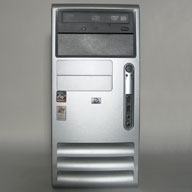 |
 |
| Click on images to enlarge. | |
One of the nice things about this system is that, unlike many home computer systems from large OEMs, you don't get a ton of useless preinstalled software. (Businesses usually don't like that stuff, and they often have their own set of programs that they use.) HP includes some diagnostics utilities, some documentation, and drivers for all the installed hardware. You might find one or two pieces of software that you want to uninstall, but thankfully, there's no spyware or other junk software. While it costs extra, one piece of software that most companies will want to get is Microsoft Office 2003. You can get the Basic, Small Business or Professional editions for $99, $219 or $299, respectively. That's slightly less than what most places charge for the OEM versions.
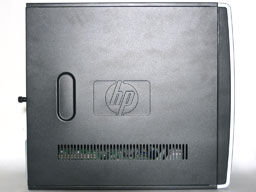 |
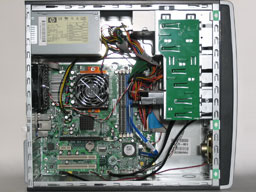 |
| Click on images to enlarge. | |
Being computer geeks, we naturally had to "pop the hood". The left side of the case is secured by a single thumbscrew, and after loosening that, it slides off. It can take a bit of effort at times, but it isn't too difficult, and the panel can be secured by a lock if desired. The internal layout of the system is clean, and there are several areas that provide for future upgrades. Available expansion options include one PCIe X16, one PCIe X1 slot, and two PCI slots; there are one free 5.25" and two 3.5" external bays - unless you choose to get a floppy drive - and there is also room for a second internal hard drive.
Most of the case features are very easy to work with. Three plastic tabs secure the front bezel, and pressing them in allows you to pull that off. That exposes all of the drive bays. The drive bays have a quick release mechanism located on the left side of the case, and the DVD and hard drive come preinstalled with bolts that serve as rails of sorts. If you need to remove a drive, lift the plastic tab, slide the drive out, and in the process, disconnect the cables from the rear of the drive. Reverse the process to install a new drive. It's extremely simple to do, and you could swap a drive in less than five minutes.
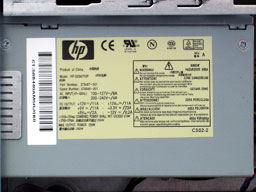 |
 |
| Click on images to enlarge. | |
The power supply is a 250W model, which is on the low end of the spectrum. However, a conservatively rated 250W power supply may actually be equal to an aggressively rated 400W PSU. We didn't encounter any problems when we loaded up the system with a high-end graphics card and a couple of TV tuners, and of course, the onsite warranty means that you're covered if problems do develop.
The expansion slots are one of the few areas that require an actual tool: either a flathead screwdriver or a Torx bit. A single screw secures a plate that locks the four expansion slot brackets in place. After removing the screw, you slide out the plate and then you can access the expansion slots. Overall, the system is clearly designed for businesses: easy to open, maintain, and repair. A small IT staff could easily support several hundred of these systems, which is exactly what most corporations do.


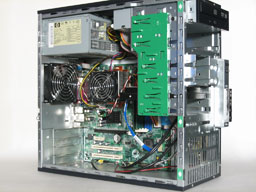








48 Comments
View All Comments
JarredWalton - Thursday, December 15, 2005 - link
I was waiting for someone to ask that. :-)Honestly, I threw them in for home users that might want to purchase such a system. For businesses, they mean nothing. Still, to a certain extent, benchmarks are benchmarks; many of the gaming tests are impacted by the GPU used, but if a system like this can handle high end game, it can certainly handle running Photoshop, Word, Excel, Internet Explorer, and all the other typical office applications.
Ditiris - Thursday, December 15, 2005 - link
I work for a small defense company (I fell/was forced into the IT position) and purchased ten of these systems for our new classified LAN where most of the work will be compute intensive applications (MATLAB simulations, for instance). I have, up until this time purhcased Dell systems because pricing on AMD systems from other OEMs was too high to justify the performance gains over the Intel systems from Dell.It was nice to see your article follow the same line of reasoning that I did Jarred. I would be very interested in similar articles in the future, from the perspective of the small to medium business needs.
For those saying there isn't an X2 core, I can verify that indeed they do have an X2 core. I got all my systems shipped with X2 3800+ cores. I don't know if the sku numbers are right, but you can definitely get the system with an X2 core.
For the caution, the first system, which I purchased as a test system, arrived in less than a week. After testing the system with all our software and making sure there were no WinXP 64 compatibility issues, I ordered nine more on 11/23 which took until 12/14 to arrive.
I received an automatic notice from HP that there was a delay in fulfilling my order after a week and that the original ship date on my order confirmation would be, well, delayed. Since there wasn't an estimated ship date on my order confirmation, nor a new ship date on the delay notification, I can say HP's order estimation needs some work. Fortunately, this wasn't an issue for me.
I ordered the sort of bargain configuration with 160 GB drive, CD-ROM, 512 MB RAM. Because of security requirements, we are required to remove the hard drives and put them in caddies. So, I separately purchased DVD-R/W's and 4 GB of RAM for each machine. If we're taking apart the systems anyway I'm not paying 300% markup for those parts.
For what it's worth, I'm extremely satisfied with the test box I've been using for three weeks. But, you might want to talk to a CSR to see what the wait time will be if you need the systems fast.
AstroCreep - Thursday, December 15, 2005 - link
Yeah, my company has bought a few of them too. Great little systems!We've been purchasing HP (and Compaq before them) for a few years now and have been pretty happy with the quality & service (better than the Gateways we used to buy before I worked here).
We've been getting the $600 system which consists of an Athlon64 3200+, 80GB HDD, 512GB RAM. For our needs, they work wonderfully; sure we might consider something different for our CAD guys and graphic-artists, but for the rest of our users who are more or less just 'Office' people, they're great!
I can also attest to the shipping issues of HP-Direct. We have an account with them and for the last few years we bought direct. This past year however has changed my opinion - by June three of our six orders I placed direct were delayed beyond the quoted date (which was always about a week after the order was placed to begin with), so now I generally go through CDW, PC Mall, Insight, etc. Besides, HP is changing their business focus and are placing greater emphasis on selling through reseller channels versus direct. Will obviously still be an option though. ;)
OrSin - Thursday, December 15, 2005 - link
One other thing I'm sick or people stating. Amd could not uspply all the OEMs. Of course not, becuase right now they do need to. Who the hell is goig to have the capacity to supply 5 time what is in demand. If more OEM use them they will ramp up just like every other company in the world. AMD have not had a supply problem in 4 years. Intel has had chipset supply and processor supply problems off and on for the last 3 years, but no one says let stop buying intel they can't supply us stuff. I know its not all OEM problesm since most of the buying managers are old farts, that still be believe IBM is the greatest company on earth. So you see how far behind the times they are.johnsonx - Thursday, December 15, 2005 - link
it's the same old thing: no one ever got fired for buying Intel (formerly IBM). If you're an IT manager for a company, why buy AMD? If you buy Intel, and some odd problem comes up, no one will blame you (after all, Intel is THE standard). If you buy AMD, and some problem comes up, well good luck finding another job. Sure, it isn't likely, but why bother with it in the first place?JarredWalton - Thursday, December 15, 2005 - link
You also have to remember that even when Intel has had supply problems, those are mostly for the retail market. Big OEMs get first priority, and the bigger you are the higher your priority. Business OEM chips are almost never in short supply from Intel. It's the high-end "exotic" parts that are sometimes more difficult to buy, but the starndard SIPP components are almost always in abundance.OrSin - Thursday, December 15, 2005 - link
What really getting me about all the OEM is the way they just disrespect AMD systems.HP's catalog does list a since AMD system. But if you talk to them in person or go on line they push how great thier AMD systems are if you bring it up. ITs like AMD is an after thought for them. But hwta really pisses me off is the way HP had push thier low cost amd systems for the Black friday sales, then all of sudden they will not sell them any more. It stays out stock on thier site. It really mean we perfer to sell intel only we only have amd to get people to look at us.
Furen - Thursday, December 15, 2005 - link
Power supplies are rated on their output current, not their input current. If you are measuring the power draw at the plug (before the power supply) then your power draw will be quite a bit higher than what the system is actually drawing (Seasonics achieve ~85% efficiency and I doubt these PSUs are comparable to those).I would guess the efficiency of that PSU is around 80% TOPS (that's a great efficiency, since most PSUs out there struggle to hit even 75%) which would mean that your power draw is actually ~180W using a 7800GTX (225 * 0.8), which means that you should have quite a bit of juice still left (if the PSU can actually achieve a 210 or so on the 12v rail, having 70W or so on the 5v line doesn't really help).
JarredWalton - Thursday, December 15, 2005 - link
That's true, but wall power is a lot easier to measure. :-)PrinceGaz - Friday, December 16, 2005 - link
I think he's referring to this bit you wrote:"... but even in the worst-case scenario (i.e. using a 7800 GTX), power draw never reached above 225 Watts. You would still have enough room to add a second hard drive, assuming that the power supply can sustain 250 Watts."
That situation when the INPUT power was 225 watts most probably meant that the OUTPUT power from the PSU was likely to be no more than 180 watts. That is a full 70 watts under the 250 watts the PSU is rated at, whereas you suggest there was only 25 watts to spare. But a very good review overall, Jarred.